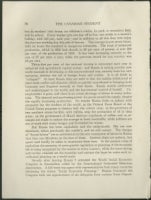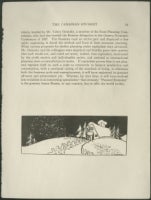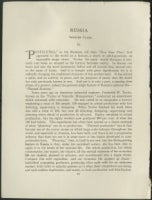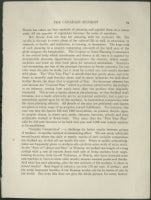Dana Porter Library, first floor
University of Waterloo Library
Waterloo, Ontario N2L 3G1
519-888-4567 x42619 or x42445
Part II, December 1931
SPENCER CLARK
II.
"PYATELETKA," as the Russians call their "Five Year Plan," first appeared to the world as a fantasy, a myth of self-hypnotism, an impossible magic vision. To-day the same world discusses it seriously and looks on amazed as the fantasy becomes reality. In Russia one hears and sees the word incessantly before and all around him, second only to the name of Lenin. And it is fraught with great significance, for it is radically changing the traditional character of this ancient land. It has stirred a spirit, and an activity in peace, and for purposes of peace, that the world has only previously known in war. And yet it is only a part, a passing time phase, of a greater, indeed the greatest single feature of Russia's national life—"Planned Economy."
Some years ago an American industrial engineer, Frederick W. Taylor, known as the "Father of Scientific Management," conducted an experiment which attracted wide attention. He was called in to reorganize a factory employing a total of 105 people, 100 engaged in actual production with five directing, supervising or designing. When Taylor finished his work there was still a total of 105, but now 25 directing, designing, supervising and planning every detail of production in advance. Eighty remained in actual production ; but the eighty workers now produced 300 per cent. of what the 100 had before. This experiment has often been quoted as a classic example of what "planning" can do to production. "Planned production" has in fact become one of the corner stones on which large scale industry throughout the world, and especially in America, has been built, and there is not a progressive industry that does not use it in some more or less highly developed or comprehensive form. "Planning," then, in itself is not new, but the distinguishing feature in Russia is that, under her socialized society, she has been able to apply it to the whole of her national life. Her whole production, her whole consumption, her export, her import, all the myriad elements of her economic life are studied, planned in advance, and co-ordinated into a single whole. Compare this with capitalism, and our economic life appears a§ chaos—individual competing producers, producing what each wills for an unknown market, with lucky or unlucky guesses as to what their competitors are doing, and with endless duplication, and waste, in both production and distribution. Russia has taken our best methods of planning and applied them on a vaster scale, till the anarchy of capitalism becomes the order of socialism.
But Russia does not stop her planning with her economic life. She carries it through to every phase of her cultural life as well, to education, to research, to health, and sanitation, to housing, to recreation. The huge task of such planning in a country comprising one-sixth of the land area of the globe staggers the imagination. The Gosplan or State Planning Commission is the central body which coordinates and directs it all, but it is assisted by innumerable planning departments throughout the country, which supply statistics and draw up their local plans for tentative submission. Statistics and accounting are two of the principal functions in Soviet economy, for not only must the plan be made, but it must be carried out, and results checked with plans. The "Five Year Plan" is sub-divided into yearly plans, and even down to monthly and five-day plans, and in many industries the individual worker knows the share that is expected of him. An important element has now become the "Counted Plan," which is a revision submitted by the workers in an industry, stating how much more they can produce than originally requested. This is now a regular phase in the planning; so that the final draft becomes, not a mark arbitrarily set by an external authority, but a goal cooperatively agreed upon by all the workers, in harmonious conjunction with the state planning officials. All details of the plan are published, and figures are given at every stage of its progress toward fulfillment. For instance, this year one sees the figures 518 and 1040 everywhere, on posters, electric signs, on graphic charts, in street cars, parks, theatres, factories, schools and even artistically worked in flower-beds. They mean that the "Five Year Plan" calls for 518 new factories to be built this year and 1,040 new tractor stations to be established.
"Socialist Competition",—a challenge for better results between groups of workers—is another method of stimulating effort. We saw many tabulated record-boards where the daily or weekly results of such socialist competition are chalked up, so that all can watch the race. Prizes or public acknowledgment are frequently given to workers who perform some work of extra merit. In the "Park of Culture and Rest" in Moscow, we walked the length of a long avenue with a row of statues down each side of living workers from neighbouring factories, from far-off Turkestan, or Siberia, who have invented some new machine or have in some other worthy manner merited praise and thanks. And what has such planning, plus the new attitude of the workers, to show in actual results? Real wages in industry are now 170 per cent. of prewar; and the social insurance benefits of the Russian worker are far in excess of any in the world. But even this does not give the whole picture, for every factory has its workers' club house, its children's creche, its park or recreation field, and its school. Every worker gets one day off in five, two weeks to a month's holiday, with full pay, each year—and in addition to all this they now enjoy the shortest working day this side of heaven. The average is now seven hours, with six hours the standard in dangerous industries. The total of industrial production, which in 1921 had shrunk to 20 per cent. of prewar, is now 300 per cent. of the production of 1913. It has been increasing recently at the rate a 27 per cent. a year, while the previous record for any -country was 12 per cent.
Thirty-five p er cent. of the national income is reinvested each year in industrial and agricultural capital outlay; and Russia is setting another new world example in developing at this unprecedented rate, entirely from her own resources, without the aid of foreign loans and credits. Is it all liable to "collapse?" At least Russia does not need to fear the sudden withdrawal of short-term credits and deposits, which so quickly contributed to bringing both Germany and England recently to their knees. Russia stands unfettered and unmortgaged to the world, and she has internal control of herself. Unemployment is gone, and there is an actual shortage of labour in many industries. The demand and purchasing power for goods exceed the supply, despite the rapidly increasing production. No wonder Russia looks on aghast, with sympathy for the workers of the world, as the Federal Farm Board of the United States purposes to destroy half the cotton crop; as the governors of two southern states forcibly, with militia, stop the production of oil in their areas; as the government of Brazil destroys trainloads of coffee; and as attempts are made to reduce the acreage in basic foodstuffs; while millions are out of work with many hungry and ill-clothed for winter.
er cent. of the national income is reinvested each year in industrial and agricultural capital outlay; and Russia is setting another new world example in developing at this unprecedented rate, entirely from her own resources, without the aid of foreign loans and credits. Is it all liable to "collapse?" At least Russia does not need to fear the sudden withdrawal of short-term credits and deposits, which so quickly contributed to bringing both Germany and England recently to their knees. Russia stands unfettered and unmortgaged to the world, and she has internal control of herself. Unemployment is gone, and there is an actual shortage of labour in many industries. The demand and purchasing power for goods exceed the supply, despite the rapidly increasing production. No wonder Russia looks on aghast, with sympathy for the workers of the world, as the Federal Farm Board of the United States purposes to destroy half the cotton crop; as the governors of two southern states forcibly, with militia, stop the production of oil in their areas; as the government of Brazil destroys trainloads of coffee; and as attempts are made to reduce the acreage in basic foodstuffs; while millions are out of work with many hungry and ill-clothed for winter.
But Russia has been capitalistic and she understands. She can now distribute, where previously she couldn't, and we still cannot. The charges of "forced labour" are so antithetical to the very conception of labour in Russia that they are ridiculous on the face of them. Answers there are aplenty, but space need hardly be taken to enumerate them here. In the present crisis of capitalism the necessity of some greater regulation or planning of the economic life is being recognised by the leaders in every country, while the more daring and farther visioned see the necessity and nurture the hope for some such coordinated planning on a world scale.
Shortly after leaving Ru ssia I attended the World Social Economic Congress in Amsterdam called by the International Industrial Relations Association. A full week was spent with representatives from many countries discussing the theme "Social Economic Planning." Russia honoured the Congress with the appointment of six delegates from various State Departments, headed by Mr. Valery Ossinsky, a member of the State Planning Commission, who had also headed the Russian delegation to the Geneva Economic Conference of 1927. The Russians took an active part and displayed a fine spirit, explaining in detail the method and form of their economic planning. When various proposals for similar planning under capitalism were advanced, Mr. Ossinsky and his colleagues were skeptical and frankly gave their opinion that such would not, and could not work; indeed, that capitalism, dominated by the profit motive and individualist action, and national or international planning were a contradiction in terms. If capitalism proves that it can plan, and regulate itself on such a scale as constantly to balance production and consumption, with a continual raising of the standard of living, to eliminate both the business cycle and unemployment, it will have registered its greatest advance and achievement yet. Whether, by that time, it will have evolved into socialism is an interesting speculation—but certainly "Planned Economy" is the greatest lesson Russia, or any country, has to offer the world to-day.
ssia I attended the World Social Economic Congress in Amsterdam called by the International Industrial Relations Association. A full week was spent with representatives from many countries discussing the theme "Social Economic Planning." Russia honoured the Congress with the appointment of six delegates from various State Departments, headed by Mr. Valery Ossinsky, a member of the State Planning Commission, who had also headed the Russian delegation to the Geneva Economic Conference of 1927. The Russians took an active part and displayed a fine spirit, explaining in detail the method and form of their economic planning. When various proposals for similar planning under capitalism were advanced, Mr. Ossinsky and his colleagues were skeptical and frankly gave their opinion that such would not, and could not work; indeed, that capitalism, dominated by the profit motive and individualist action, and national or international planning were a contradiction in terms. If capitalism proves that it can plan, and regulate itself on such a scale as constantly to balance production and consumption, with a continual raising of the standard of living, to eliminate both the business cycle and unemployment, it will have registered its greatest advance and achievement yet. Whether, by that time, it will have evolved into socialism is an interesting speculation—but certainly "Planned Economy" is the greatest lesson Russia, or any country, has to offer the world to-day.






